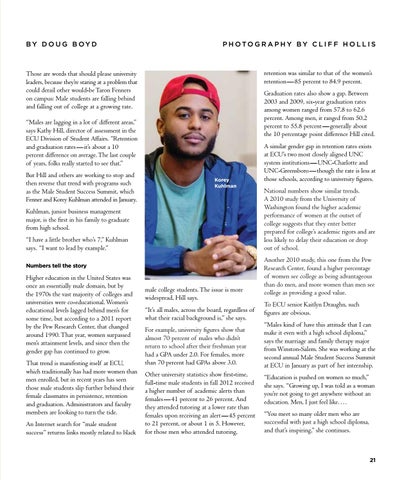BY D O U G B OY D
PHOTOGRAPHY BY CLIFF HOLLIS
retention was similar to that of the women’s retention— 85 percent to 84.9 percent.
Those are words that should please university leaders, because they’re staring at a problem that could derail other would-be Taron Fenners on campus: Male students are falling behind and falling out of college at a growing rate.
Graduation rates also show a gap. Between 2003 and 2009, six-year graduation rates among women ranged from 57.8 to 62.6 percent. Among men, it ranged from 50.2 percent to 55.8 percent— generally about the 10 percentage point difference Hill cited.
“Males are lagging in a lot of different areas,” says Kathy Hill, director of assessment in the ECU Division of Student Affairs. “Retention and graduation rates—it’s about a 10 percent difference on average. The last couple of years, folks really started to see that.” But Hill and others are working to stop and then reverse that trend with programs such as the Male Student Success Summit, which Fenner and Korey Kuhlman attended in January.
Korey Kuhlman
Kuhlman, junior business management major, is the first in his family to graduate from high school. “I have a little brother who’s 7,” Kuhlman says. “I want to lead by example.” Numbers tell the story
Higher education in the United States was once an essentially male domain, but by the 1970s the vast majority of colleges and universities were co-educational. Women’s educational levels lagged behind men’s for some time, but according to a 2011 report by the Pew Research Center, that changed around 1990. That year, women surpassed men’s attainment levels, and since then the gender gap has continued to grow. That trend is manifesting itself at ECU, which traditionally has had more women than men enrolled, but in recent years has seen those male students slip further behind their female classmates in persistence, retention and graduation. Administrators and faculty members are looking to turn the tide. An Internet search for “male student success” returns links mostly related to black
male college students. The issue is more widespread, Hill says. “It’s all males, across the board, regardless of what their racial background is,” she says. For example, university figures show that almost 70 percent of males who didn’t return to school after their freshman year had a GPA under 2.0. For females, more than 70 percent had GPAs above 3.0. Other university statistics show first-time, full-time male students in fall 2012 received a higher number of academic alerts than females— 41 percent to 26 percent. And they attended tutoring at a lower rate than females upon receiving an alert — 45 percent to 21 percent, or about 1 in 5. However, for those men who attended tutoring,
A similar gender gap in retention rates exists at ECU’s two most closely aligned UNC system institutions—UNC-Charlotte and UNC-Greensboro—though the rate is less at those schools, according to university figures. National numbers show similar trends. A 2010 study from the University of Washington found the higher academic performance of women at the outset of college suggests that they enter better prepared for college’s academic rigors and are less likely to delay their education or drop out of school. Another 2010 study, this one from the Pew Research Center, found a higher percentage of women see college as being advantageous than do men, and more women than men see college as providing a good value. To ECU senior Kaitlyn Draughn, such figures are obvious. “Males kind of have this attitude that I can make it even with a high school diploma,” says the marriage and family therapy major from Winston-Salem. She was working at the second annual Male Student Success Summit at ECU in January as part of her internship. “Education is pushed on women so much,” she says. “Growing up, I was told as a woman you’re not going to get anywhere without an education. Men, I just feel like…. “You meet so many older men who are successful with just a high school diploma, and that’s inspiring,” she continues.
21
